When dealing with cryptocurrencies, understanding gas tokens and their application is crucial for effective management, especially when using platforms like ImToken Wallet. This article will detail the gas tokens supported by ImToken, their functions, and provide actionable tips to improve your experience and boost productivity as you navigate this digital landscape.
Gas refers to the unit that measures the computational work required to perform operations on a blockchain. Every transaction executed on the Ethereum network, for example, requires a certain amount of gas to process. The price of gas fluctuates with great variability, which can significantly affect transaction costs. Here’s a closer look at the importance of gas in the cryptocurrency ecosystem:
Transaction Costs: Gas prices determine how much users pay to execute a transaction or run a smart contract, affecting overall transaction efficiency.

Network Congestion: During peak times, gas prices can increase. Understanding this can help users optimize their transaction timings for cost efficiency.
ImToken Wallet supports several gas tokens, enabling seamless transactions within the cryptocurrency ecosystem. Here’s a breakdown of these tokens:
The primary gas token for the Ethereum network is Ether. It is used to pay transaction fees and computational services on Ethereum. Here are some key details:
Functionality: Every Ethereum transaction requires ETH as gas, particularly when interacting with smart contracts.
Accessibility: ETH is readily available on numerous exchanges and can be easily stored and managed through ImToken Wallet.
Binance Smart Chain supports multiple tokens as gas, primarily BNB. Here’s a brief overview:
BNB (Binance Coin): Within the Binance Smart Chain, BNB serves as the gas fee token, and it is used for transaction fees, staking, and participating in token sales.
Benefits: Using BNB can yield discounts on transaction fees if you use it for gas payments.
Polygon is a Layer 2 scaling solution for Ethereum, and it uses MATIC as its native gas token. Here’s why it’s beneficial:
Efficiency: Utilizing MATIC for gas fees significantly reduces costs compared to Ethereum, making transactions faster and cheaper.
Support: ImToken supports MATIC, allowing users to manage their funds efficiently.
Avalanche is another blockchain platform where AVAX is used as the gas token. Here’s a snapshot:
Interoperability: AVAX provides users with low transaction fees and ensures high throughput across various applications on the Avalanche network.
Integration with ImToken: Users can easily store and transact AVAX directly from their ImToken wallets.
Although Solana operates differently, managing transaction costs is crucial. SOL is its native token used for gas fees. Here’s what to know:
Speed: Solana boasts high transaction speeds with minimal fees, allowing users to make quick transactions.
Support in ImToken: ImToken users can hold, send, and receive SOL without hassle.
Managing cryptocurrency can be daunting, but adopting effective strategies can simplify your tasks. Here are five productivityboosting tips specifically for handling gas transactions:
Use tools and platforms that track gas prices in realtime. Websites like Etherscan provide insights into current gas prices, helping you make informed decisions about when to execute transactions.
Before making a transaction, check an ETH gas tracker. If the gas price is significantly high, consider delaying your transaction to save on costs.
Gas prices are affected by network congestion. Transactions may cost more during peak hours.
Analyze transaction patterns and the times when gas prices dip, such as late weekends or early mornings, to execute your transactions.
Setting an appropriate gas limit helps ensure that transactions are processed without overpaying.
Check similar transactions on platforms like Etherscan to determine a suitable gas limit.
Various wallets, including ImToken, allow users to choose between standard and fast transaction options.
If your transaction isn't urgent, select the standard option to minimize fees, while reserving faster options for highpriority transactions.
Regularly monitoring gas tokens in your wallet can help you manage and allocate funds more effectively.
Schedule weekly reviews of your wallet through ImToken to assess your gas token balances and plan any necessary transactions.
Answer: The primary gas token for Ethereum transactions within ImToken Wallet is Ether (ETH). It is essential for covering gas fees when executing any function on the Ethereum network.
Answer: You can purchase gas tokens directly through ImToken Wallet by linking your wallet to a decentralized exchange (DEX) or using thirdparty services. Typically, you would need to exchange a cryptocurrency like USDT for the desired gas tokens.
Answer: Gas prices are influenced by various factors, including network congestion, demand for transaction execution, and the complexity of the transactions themselves. Users can pay higher gas prices to expedite transaction processing during peak times.
Answer: No, only the gas tokens supported by the specific blockchain can be used to pay for gas fees. For instance, ETH is required for transactions on the Ethereum network, while BNB is used on Binance Smart Chain.
Answer: ImToken Wallet itself does not charge fees for using the wallet or conducting transactions; however, users are responsible for covering gas fees associated with their transactions on the blockchain.
Answer: Setting a low gas price may cause your transaction to take longer to process or possibly be rejected by the network. Transactions with insufficient gas prices may get stuck in the mempool, awaiting processing by miners.
By understanding which gas tokens are supported by ImToken Wallet and effectively managing them, users can optimize their experience and minimize costs when engaging with the cryptocurrency ecosystem. Using the mentioned productivity techniques, you can enhance your crypto transactions while navigating the complex world of blockchain with ease.